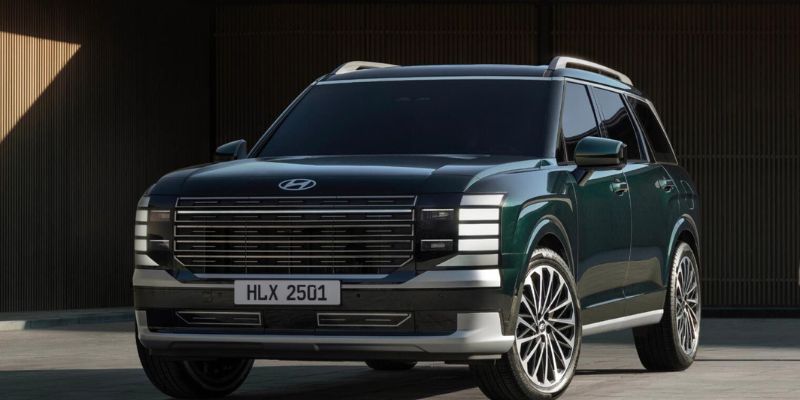A Bold New Presence
Hyundai’s revamped flagship three-row SUV embraces a bolder aesthetic with sharp edges, stacked LED light blocks, and dramatic blacked-out pillars that lend Range Rover–like sophistication. Despite its upright profile, Hyundai claims the redesigned SUV achieves a low drag coefficient (~0.31) thanks to aerodynamic tweaks like active airflow shutters, improved wheel arches, and a slightly stretched body for a 2.7‑inch longer wheelbase and around 2.5 inches extra overall length.
Available wheel sizes go up to 21 inches on higher trims, filling the fenders decisively and conveying road presence.
Tech-Rich, Upscale Interior
Step inside and you're greeted by a luxurious, lounge-like cabin. A curved panel houses dual 12.3-inch screens—one for the driver cluster and one for infotainment—seamlessly integrated with physical climate and function controls for user-friendliness.
Premium materials—such as quilted Nappa leather, soft-touch surfaces, aluminum trims, and ambient lighting—give high-end vibes. Higher trims offer Relaxation Seats (reclining with leg support), ventilated second-row seats, second-row captain’s chairs, power-folding third row, and even massage front seats. Hyundai also includes innovation staples such as wireless Apple CarPlay and Android Auto, multi‑port fast‑charging USB‑C, and a 15‑watt wireless charging pad with cooling fan.
Safety tech includes Hyundai SmartSense: forward collision-avoidance, blind‑spot collision assist, lane‑following/cruise control, safe‑exit assist, remote smart parking, and rear occupant alert using cabin cameras
Empty Paragraph
Powertrain Options: Gas and Hybrid
For gasoline shoppers, a refined 3.5‑liter V6 delivers around 287 hp through an 8‑speed automatic, with front- or optional all-wheel drive, and towing capacity up to 5,000 lbs.
The hybrid debut is the big news: a plug-in pairing of a turbocharged 2.5‑liter inline-4 and electric motors delivers 329 hp and 339 lb‑ft torque, with estimated highway fuel economy exceeding 30 mpg and a driving range over 600 miles. AWD is standard on hybrid models, which can tow up to 4,000 lbs.
Off-Road Ready: Meet the XRT Pro
The debut of the Palisade XRT Pro brings genuine off-road capability to the lineup. It adds rugged styling, 8.4 inches of ground clearance (vs. 7.4 standard), all-terrain tires, an electronic rear limited-slip differential, and drive modes like Mud, Sand, Snow, and Tow. Recovery hooks, enhanced camera views, and skid plates round out the package.
Pricing & Availability
US-spec pricing starts at $40,430 for the base SE model—about $1,700 higher than the previous generation. Trim pricing climbs steadily, topping $55,555 for the Calligraphy gas trim. Hybrid versions start at around $45,155, reaching up to $57,775 for the best-equipped Calligraphy Hybrid model
MotorTrend.
Gas models are hitting dealerships in summer 2025, while Hybrid trims follow in fall 2025.
Why the 2026 Palisade Matters
Redesign ambition: The second generation brings a polished, refined styling makeover and more spacious footprint.
Powertrain diversity: Traditional V6 meets fuel-saving hybrid and even plug-in capability, offering flexibility.
Luxury-level interior at mainstream pricing—complete with premium materials, massaging seats, and advanced infotainment.
Off-road credentials in XRT Pro add utility and attitude.
Tech-first thinking: From OTA updates and Hyundai Pay to Digital Key 2.0 Premium and cabin dash cams, it’s thoroughly modern.
Final Thoughts
With upscale styling, roomy and luxurious interior, and flexible powertrain offerings—including the first-ever hybrid in giant three-row format—the 2026 Hyundai Palisade stakes its claim as one of the most compelling midsize SUVs in its class. Whether you opt for the premium refinement of the Calligraphy, the hybrid fuel economy, or XRT Pro off-road grit, it's clear Hyundai set out to redefine what a family SUV can be.
Curious about a trim comparison, fuel-economy details, or how the hybrid stacks up against rivals like the Kia Telluride or Toyota Highlander? We've got you covered!


